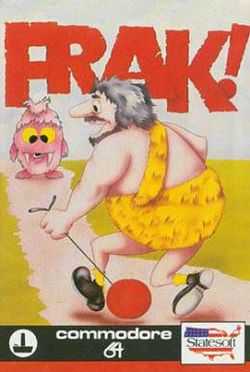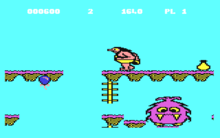Frak!
| Frak! | |
|---|---|
 | |
| Developer(s) | Aardvark (BBC / Electron) The B Team (C64) |
| Publisher(s) | Aardvark (BBC / Electron) Statesoft (C64) |
| Designer(s) | Orlando |
| Platform(s) | Acorn Electron, BBC Micro, Commodore 64 |
| Release date(s) | 1984 (BBC / Electron) 1985 (C64) |
| Genre(s) | Platform game |
| Mode(s) | Single-player |
| Distribution | Cassette (later disk as part of compilations) |
Frak! is a 1980s computer game originally programmed by Orlando (aka Nick Pelling) for the BBC Micro and Acorn Electron and published by his own 'Aardvark' software label in 1984. The game was noted for its "outstanding" graphics, with its characters being compared in one review to early Disney cartoons.[1]
The game was ported to the Commodore 64 the following year by 'The B Team' (Jason Perkins, Anthony Clarke and Mark Rodgers). The BBC and Electron versions were included on the Superior Software compilation Play It Again Sam 4 in 1987 and re-issued in budget form by 'Alternative Software' in 1989.
Gameplay
Frak! is a side scrolling platform game in which the player controls a caveman named Trogg. In each level, Trogg's object is to find three keys located on the level. The platforms and ladders (replaced by logs, ropes and chains on later levels) constituting the level are laid out in a very tricky form. When Trogg steps off a platform, he does not fall straight down, but instead slides diagonally downwards. Added to the fact that long falls will kill Trogg, this calls for very skillful jumping among the platforms. Trogg exclaims "Frak!" (presumably an expletive) each time he dies. When the user manages to complete the three levels, they are returned to the first level with the screen display upside down. The game then repeats the same three stage sequence, following which it rotates 90 degrees and repeats again. Subsequent loops consist of video being displayed in black and white and rotated, and also the display being flashed on and off in three second intervals.



Enemies in Frak! come in three forms: the large, hairy Scrubbly, pig-like Poglet and large nosed Hooter (each static, as 'statues'), balloons and daggers. The statues obviously stay still, whereas the balloons fly straight upwards and the daggers fly diagonally downwards. Contact with any enemy will kill Trogg. To combat the enemies, Trogg is armed with a yo-yo that he can launch straight horizontally. The yo-yo will kill any enemy it comes into contact with.
Each level also has a time-limit, which can be topped up by the occasionally found light bulbs. However, if the time runs out, the level does not end - instead, the game continues in the dark. After this point, the yo-yo can still be used to remove the static enemies from the level but will not affect balloons and daggers.
Frak! encodes high scores as nonsensical secret messages, such as Hairy gonks kiss green Buddhas slowly.
Conversions
When the original BBC Micro version was converted for the Acorn Electron, the screen mode was changed from four colours to two because of the Electron's inferior video speed. The extra RAM freed up by the smaller frame buffer made it possible to include extra levels (bringing the total to nine against the BBC's three) and a screen designer which was not in the BBC original. The C64 version has six levels. Each level is much larger than the visible screen, and has a distinct graphical style and catchy background music (different for each level).
In the 1990s, an attempt was made to port Frak! to the Amiga, with updated graphics (including "frak!tals" in the background), but the port was never finished.
Copy protection
As part of the copy protection, illegal copies would cause a fully polyphonic rendition of Trumpet Hornpipe, the Captain Pugwash theme tune, to play endlessly rather than loading the game properly (Pugwash being a pirate). On the Electron, this 'piracy' tune was replaced by the tune Yakety Sax, the theme from 'Benny Hill'. The playback on the Electron was made more impressive by the fact that the machine could only play a single note at a time (it used a monophonic version of the sound chip), thus the polyphony was achieved via 50 Hz interrupt-driven note-switching to achieve the necessary chords.
References
- ↑ Quinn, Tony (September 1984). "Rock with the caveman". Acorn User. p. 155. Retrieved 20 February 2014.